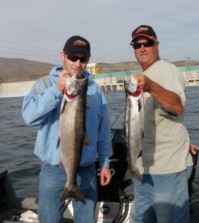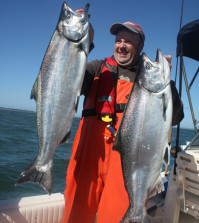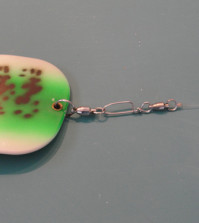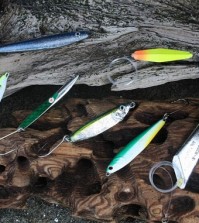When a Light Jig is the Right Jig

Back in the late-seventies, when vertical jigging was just beginning to catch on among Northwest salmon anglers, there weren’t many choices when it came to jig styles, so we bought whatever we could find and adapted our jigging technique to the available weaponry. But as interest in jigging grew, the tackle industry responded, and within a few years there was a metal jig of the right size, shape and color for every salmon-fishing situation a Northwest angler was likely to encounter. Now there are so many options that it might be difficult to decide which jig to tie onto your line at the start of the fishing day.
Two words of advice for the next time you’re peering into a tackle box full of jigs trying to make that choice: start small.
Two of several keeper-size Chinook that fell for 2-ounce jigs bounced along the bottom in 50 to 60 feet of water. From left: Point Wilson Candlefish jig, Yellow Bird KandleFish, Luhr Jensen Crippled Herring, Point Wilson Anchovy jig.
Veteran jiggers know that a smaller, lighter jig does more wiggling, wobbling and darting as it falls through the water than does a big, heavy jig, and a livelier jig is more likely to draw interest down there where it counts than is a lifeless slab of metal. Besides that, a day of jigging with a 1 ½- or 2-ounce jig causes a lot less wear and tear on your body—especially your jigging arm—than a day of lifting and dropping a 4- or 5-ouncer. It’s a well-known unscientific fact that jigging all season with a too heavy jig is the number two cause of tendonitis of the elbow; right behind hand-splitting a winter’s supply of fire wood. There’s a reason why that ailment is commonly referred to as “jigger’s elbow.” I’m sure you can look that up somewhere on the Internet.
Another reason to think small when choosing a jig is that sometimes a sulking or even a finicky Coho may pass up a full-meal-deal-size lure but still inhale a snack-size version of the same offering. I can recall a number of times over the years when I’ve watched my depthsounder as a concentration of fish totally ignored one of my favorite (larger) jigs as it worked over, under, around and through them, then had a take on the first drop after replacing the big jig with one half its size. It doesn’t happen every time, but often enough that I know there’s something to it.
Yet another advantage to fishing smaller jigs is that salmon—as well as other sport fish—are likely to inhale a small jig deeper into their mouths, increasing your odds of getting a solid hook-up on the set. And when you do hook ‘em, there’s a better chance they’ll stay stuck, because there isn’t as much lure weight swinging and twisting through the water, providing leverage to dislodge the hook. That’s an especially important consideration in these days of barbless-hook regulations on so many of our favorite salmon grounds.
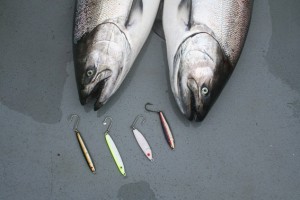
Two of several keeper-size Chinook that fell for 2-ounce jigs bounced along the bottom in 50 to 60 feet of water. From left: Point Wilson Candlefish jig, Yellow Bird KandleFish, Luhr Jensen Crippled Herring, Point Wilson Anchovy jig.
But hold on a bit before you rid your tackle box of every jig over three ounces and melt them all down to make downrigger weights. There will be times when you need them because there are limitations on when and where you can fish those lighter jigs effectively. If you’re out there in 150 feet of water and all the salmon you’re marking are within 10 feet of the bottom, you’re probably not going to reach them with a 1 or 2 ounce jig unless you’re using extremely light line and both weather and water conditions are dead-calm. You can’t catch fish you can’t reach, and it’s hard to reach fish with a lightweight jig in deep water, especially if there’s any wind or current. And remember, a metal jig is usually most effective when it’s being fished straight up and down, so you’re much better off fishing a heavy jig vertically through the water column than you are fishing a too-light jig diagonally.
So, what conditions are most conducive to fishing success with smaller, lighter metal jigs? When you’re fishing shallow water, when fish are suspended in the upper portion of the water column, when winds and tidal flows are light, when you find fish concentrated in small areas, and when you know or suspect that fish are feeding on smaller baitfish, it’s time to break out the small stuff. Any combination of two or more of these five scenarios, of course, increases the odds that little jigs will prove deadly. Let’s look a little closer at each of these prime times to fish small jigs.
- Shallow water. Salmon, especially Chinook, may be found in estuaries, shallow bays and other near-shore feeding areas early and late in the day or on flood tides, and at those times and places you may be able to fish for them in water as shallow as 40 feet or less. Such close-range fishing is ideally suited to fishing small jigs. Even if they’re hugging bottom, which they often do in the shallows, you can reach them with jigs as small as one ounce or less, and even a very small jig will be visible throughout much of the water column, often drawing fish some distance away in for a closer look. If your electronics tell you that most fish are within a few feet of the bottom, keep your jig down there and use short jigging strokes to entice strikes. If salmon are scattered throughout the water column, retrieve your jig every 30 to 60 seconds and let it free-fall from the surface to the bottom; if the line twitches or goes slack at any time during the drop, set the hook quickly
- Suspended fish. If you’re seeing a lot of salmon between the surface and, say, 50 feet or so, and tides and winds are moderate or calm, you should be able to coax them into action with a small jig. It’s common to find Coho and pinks at such depths, and in coastal areas there’s a good chance of finding a Chinook or two as well. When jigging for suspended salmon I usually try to fish as much of the water column as possible, continually retrieving the lure and free-spooling it through the depths for as long as the line angle remains more or less vertical; when it drifts out from that vertical angle it’s time to reel in and do it again. If it drifts away from vertical too quickly, either use your kicker motor to back into the tide/wind or go to a slightly heavier jig.
- Slack tide/flat water. During those days of heavy tidal exchange, you may be able to use small jigs—or jigs of any size—during the high and low slack, and maybe not even then if there’s a moderate wind blowing. Heavy current and/or a stiff wind will move you and your boat along too fast to maintain that vertical line angle that’s so important to successful jigging, and you’re better off mooching or trolling under those conditions. But if the tide change gives you even 15 or 20 minutes of “still” water, it’s a good time to break out the jigging rod and the light jigs.
- Concentrated fish. Any time you can find a lot of salmon ganged around a school of bait fish, over some kind of underwater structure or along a current break or tide rip, you’re probably ahead of the game, whether you’re jigging, mooching or trolling, but jiggers have an advantage in those situations. That’s because when you’re jigging the way you should, you’re fishing straight up and down, directly over the fish you’re hoping to hook, and if your depthsounder is even half-way decent, you can see both the fish and your jig down there doing its thing. It’s kinda like a really good video game, but the fish on the screen are real! Unlike the troller, who will see a school of fish on his ‘sounder, pass over it and hope one of them takes his bait or lure several seconds later, a jigger who’s on his toes can use his kicker motor to hold his position over the school or move forward, back or side-to-side in order to stay on top of it. And even in the case of salmon that aren’t actively feeding, there’s something about that shiny little slab of metal dancing and darting around in front of their noses that eventually prompts one of them to grab it before someone else does.
- Small bait. Just like fly fishermen on a trout stream, there are times when salmon fishermen have to “match the hatch” to make ‘em bite, and when they’re feeding on tiny herring, anchovies or candlefish, a two-inch-long jig may be just the right imitation for the job. Salmon that have been on a small-bait diet for any length of time seem to become programmed in on those tiny tidbits, and sometime appear to actually lose interest in “normal” size baits and lures, but a jig that looks just like the dozens of meals they’ve had in the past week may have “Eat Me” written all over it.
So, if the smallest jig in your tackle box weighs in at four or five ounces, you may be missing out on some good salmon fishing, so give serious thought to stocking up on a good selection of jigs in the half-ounce to 2-ounce range. There are plenty of options. Buzz Bomb-Zzinger Lures of British Columbia makes its sliding Zzinger jigs in a half-ounce and 1 ½-ounce size and a wide range of colors. Luhr Jensen’s Crippled Herring jig is available in weights from half an ounce to 2 ounces, and both the pearl and nickel/neon green finishes have put a lot of salmon in my fish box. The 1-ounce and 2 ¼-ounce Point Wilson Dart Candlefish and 1-ounce and 2-ounce Point Wilson Anchovy jigs are all proven salmon-getters, as is the KandleFish jig from Yellow Bird Products, available in sizes from one-sixth of an ounce to 6 ounces. The KandleFish jig, by the way, was developed by long-time lure innovator and expert jigger Pete Rosko, inventor of the Crippled Herring. Rosko also developed the newest of the small jigs that are making a splash on the Northwest salmon-fishing scene, Mack’s Lures’ Sonic Baitfish. It’s available only in sizes up to three-quarters of an ounce, but that’s enough for shallow-water and light-tackle salmon fishing. The Sonic Baitfish is unique in that it can be attached to the line at any of three points, the nose, the tail or the middle. If you go with that third option, the jig stays in a fish-getting horizontal position all the time, and you can put a hook at each end to increase your odds of connecting when you set the hook.
Down-sizing your tackle a little may improve your success with any of these smaller, lighter jigs. Stick with braided line, but instead of the 50- or 65-pound braid you typically use, drop down to something in the 12- to 20-pound range. With that lighter line you can also get away with using a smaller-capacity reel, and the rod can be both lighter and a little shorter, as long it’s a fairly fast taper with a sensitive tip and some backbone at the bottom end. Some Northwest jiggers are even switching from revolving-spool reels to spinning tackle when they fish the light jigs in shallow water. I haven’t made that jump yet, but will probably give it a try before the summer’s over.



